Have you been seeing clownfish a lot lately and are fascinated by this colorful saltwater creature? Well, let’s say you are not the only one. Most people who see clownfish immediately get attracted by them and want to have them at home. That means it becomes essential to know all about the clownfish life cycle because you wouldn’t know what to expect.
After the female clownfish lay the eggs, it takes them 7 to 10 days for the eggs to hatch. And the newly born are known as clownfish fry. As they take their full body form, the fish reaches their juvenile stage and reaches maturity much later. And depending on whether they are in the wild or captivity and more, a clownfish can live around 3-10 years.
In this article, I have discussed everything from clown fry to interesting information regarding their sexuality. So I hope you stick around until the end.
From Eggs To Hatching/Clownfish Fry
The clownfish do not carry live fish like many other saltwater fish. Do they look like they were made for it? Of course not!
Clownfish spawns pretty frequently, such as every 10-15 days. And the females lay eggs in different types of locations in the tank. They can lay eggs on a smooth and flat surface in the tank. And sometimes, they choose to lay eggs in the anemone that the clownfish group hosts.
Soon after the female lays eggs, the males move to take charge of them. They usually ensure keeping the eggs protected from potential threats, keep them clean and also fertilize them.
One of the most interesting things about clownfish eggs is that they usually hatch at nighttime. And the hatching takes 8-10 days after the laying of the eggs. That is because of the egg’s subsequent hatching nature, and some may hatch a little earlier or later than others.
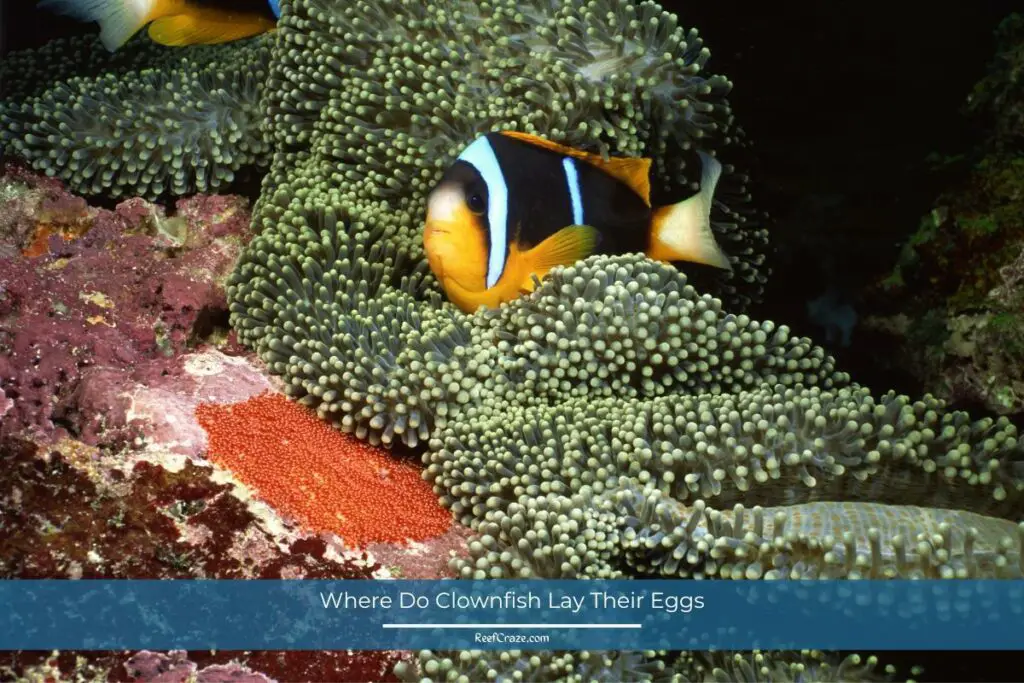
The hatched clownfish babies will be in the larvae state, meaning they will not have a full body. And they are in a very vulnerable state until they grow to have a full body because not all the larvae survive most of the time. Why?
Let’s say bad parenting! Once the eggs are hatched, the parent clownfish will no longer protect or look after the babies. And if they are hungry, they might end up eating the larvae. That is why aquarists who know this fact keep the larvae separated from the parents and feed them with rotifers.
And by the next 10 days, the larvae will take full form, and they are called clownfish fry. If these clownfish fry or babies were in the wild, they would be feeding on plankton. But the ones in captivity will require pellets or flakes at this point.
What Do Clownfish Eggs Look Like?
If you are new to this whole clownfish thing, it can be challenging for you to know if your clownfish has laid eggs. Clownfish lay around 1000 eggs during their spawning seasons. So it shouldn’t be hard to miss. However, the size of the fish eggs is incredibly small.
But have you seen poppy seeds? Or chia seeds after being soaked in water overnight? Well, let’s just say they look pretty similar. They are like small seeds stuck together. And the color of the eggs can look dark, white, or a bit orange-ish. The egg color varies depending on the parents.
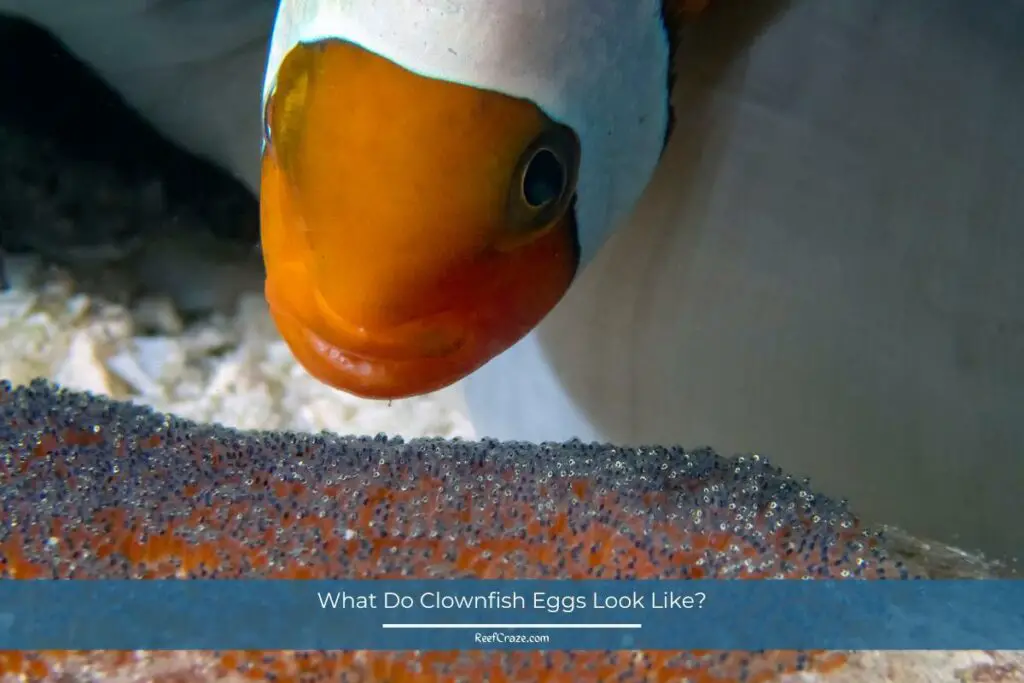
As days pass, the eggs will begin to look a bit silvery, and you will also notice tiny eyes as they glow in size. It takes around 3-5 days to reach this stage. They become more silvery as their hatching day arrives, and the eyes become more visible.
But please note that if you have different species of clownfish, you should not expect all eggs or larvae to look the same. Depending on the species, the clownfish eggs and larvae shapes and sizes can vary.
Juvenile Stage
I think the juvenile stage is the most complex stage of a clownfish. And there are reasons behind it. This stage begins as the clownfish fry reaches its full body form.
But just because it has a full body does not mean the fish has reached maturity or adulthood. And this is where things get a little confusing. The fish can remain in its juvenile stage for a no-one-knows-how-long period of time. That is because it depends on various factors.
The longevity of clownfish juvenile stage varies depending on the clownfish species, tank environments, fish health, and how you maintain the overall tank condition. Nevertheless, the juvenile stage can remain for around a year or so.
And at this stage, all clownfish will either be considered gender-neutral or just males. And this creates another issue if you are choosing clownfish as tank mates. But don’t worry about it at this point. I have discussed more on this topic in the latter part of this article.
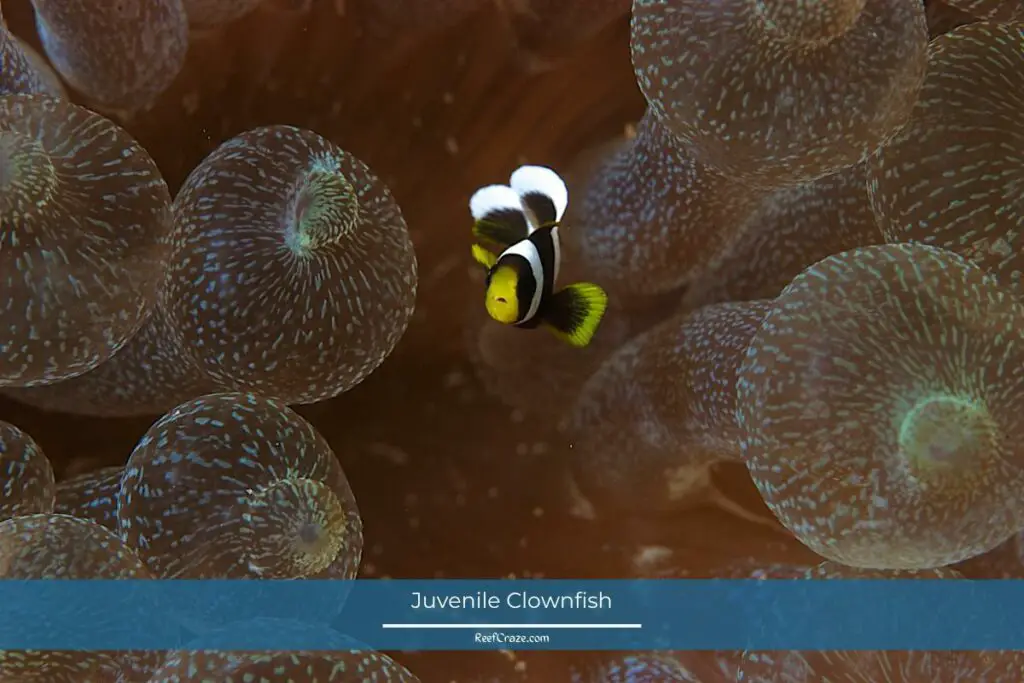
Adulthood And Breeding
Since the clownfish’s juvenile stage is uncertain, it can take longer than you expect for the fish to reach adulthood. For some clownfish, it can take around a year. But many aquarists observed that their clownfish took around one and a half and even two years to reach adulthood.
And at this stage, they begin to develop their sexual organs. The larger, stronger, and most aggressive clownfish usually turn out to be females and others males. The males remain submissive toward the female clownfish who leads the clan.
In a tank environment, the stronger of the two becomes female, and the other one remains male. The female clownfish chooses its mating partner. And when they will breed, the female clownfish will lay eggs in 2 weeks or so.
As you read already, the males take charge of caring for and fertilizing the eggs. If there are signs of any disease or bacterial growth in eggs, the males will eat them to protect other eggs.
The clownfish mates spawn pretty often, and during each spawning season, the female can lay around 1000 eggs. But sometimes the number can be as low as 100. However, considering that not all clownfish hatch, the imbalance in number makes it balanced in the end, and that is pretty natural for clownfish.
Once 10-15 days pass after the hatching of the eggs, the clownfish pair might spawn again. This breeding nature of clownfish is true whether they are breeding in the wild or in captivity.
Do Clownfish Mate For Life?
Yes, clownfish choose one partner and will mate with that partner for life. That is because clownfish are extremely monogamous and do not mate with more than one partner, unlike many other fish.
That means, even if you add many tank mates, the female will still remain to be the most dominating of the group, and the partner she chooses already will be the one it will spawn with. But how does that happen?
When a female clownfish transformation happens, the males begin to swim toward it to make an impression to attract the female. However, the female will choose only one of them. And she is usually picky and wiser in choosing her second-in-command.
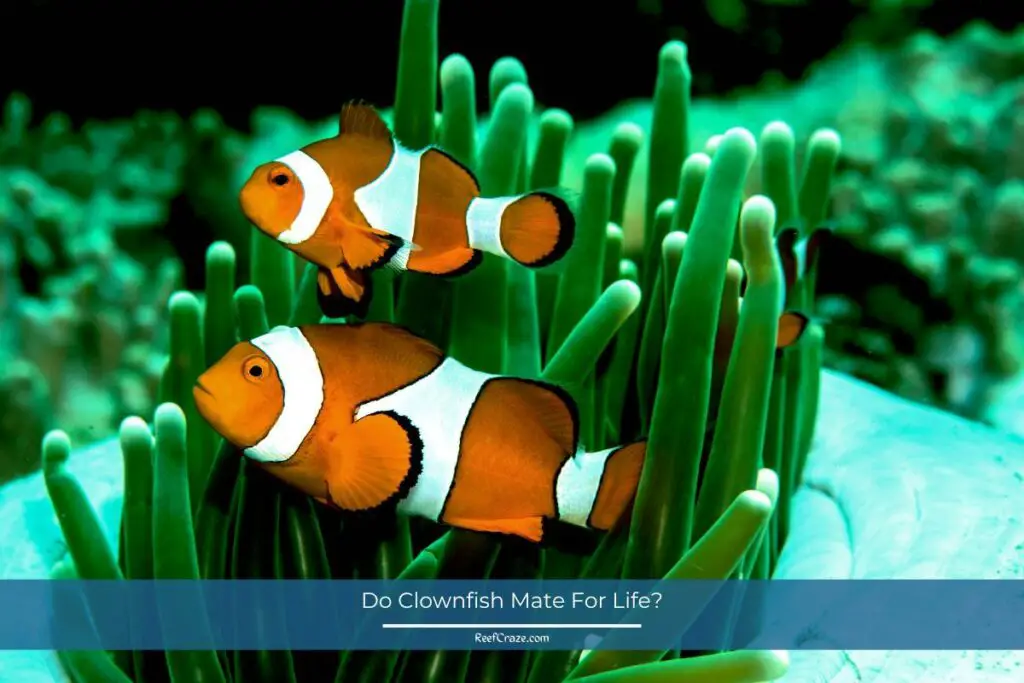
The female clownfish choose the largest of the males. Because when the eggs are laid, it is the male fish that will take charge of protecting and caring for the eggs. They will make eye contact and swim around the tank or ocean. They will nibble or bite on each other’s fins to show affection. And soon, they begin to spawn.
And both male and female clownfish will grow larger with time as they are on the top of the hierarchy and get the best food. As for the rest of the males in the tank, the female will not mate with them. In fact, the newly found pair will begin to bully the juveniles.
This will go on until one of them eventually dies. And if that happens, there will be another shift in the environment and breeding hierarchy.
What Happens If One Of The Breeding Clownfish Dies?
The tank environment hierarchy will shift once one of the breeding clownfish or clownfish mates dies. It could take more shifts if the dead one were a female. Because the female clownfish is usually the alpha, and the paired male mate is a beta. The rest (if there are any more) are considered to be still in their juvenile stage.
As a male and a female clownfish become a pair for breeding, one of them drying means there will no longer be any reproduction. Not unless there are more juvenile or male clownfish in the environment.
If the female clownfish dies, the paired or beta male will turn into a female and will be the next alpha. And from among the juveniles, one of them will turn into a beta male. And if the beta male dies, the second strongest male will replace the dead beta male. And that goes for both captivity and the wild.

However, when it comes to clownfish in captivity, things can often turn out a lot different sometimes. Because of clownfish’s aggressive behavior, most tank owners keep them in pairs only. So when one of the breeding fish dies, the change in their sexes or beta males does not happen.
So tank owners choose a new tank mate for them. If a female dies, and you add another male clownfish, the biggest and most aggressive of the two will become a female. And if a male dies, you will just have to add a new male and hope they both get along. Because when there are only 2 clownfish in the tank, it takes quite some time for them to adjust and become a breeding pair.
What Happens When A Clownfish Mother Dies?
If a mother or female clownfish dies, the beta male that she chose for breeding will gradually turn into the next female. This new female will become the alpha and dominate over the other fish in the tank or group. The alpha female will choose the next beta male, and they will spawn.
This changing process for both fish can take a week or two, depending on the tank environment and how they cope. And that is how the circle goes on.
Are All Clownfish Born Male?
The most straightforward answer is yes. All clownfish are born male by default, and clownfish eggs do not produce any female clownfish at that stage. And they remain male from their newborn age to the juvenile stage. But things change when they begin to reach adulthood.
As the juvenile clownfish begin to reach adulthood, they start to fight each other to show dominance. In the end, the strongest and the most dominant male clownfish will turn into the alpha female. And the second strongest male will become the beta, and the female will pair with it.
So what about the rest of the young males? Well, let’s just say they will remain in their juvenile or semi-juvenile stage until the cycle breaks.
Difference Between Male And Female Clownfish
As a new clownfish owner, detecting the male and female ones can be challenging. While clownfish from the same species look pretty similar, there are still ways to know the differences between males and females.
First of all, the female clownfish will be larger than the male. And you already know why. The larger clownfish is the symbol of strength and dominance. That is why all female clownfish appear bigger than males.
Other than a larger body appearance, the male will be smaller in size than the female. An alpha female can measure around 4 inches, while the male can be 2.5-3 inches tall. Besides, the female clownfish is usually the most aggressive one in the group or between the pair.
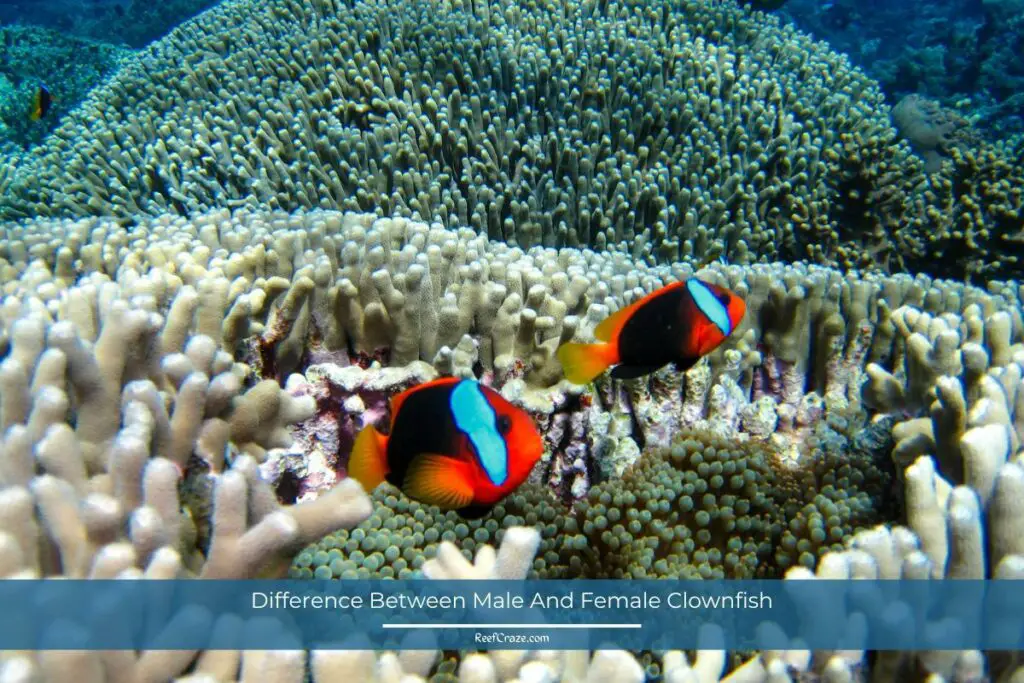
And if you are looking for the beta male among several clownfish, compare the size of the rest of the males. Apart from the female, the largest male is the beta and the female’s mate.
Are Clownfish Hermaphrodites?
Hermaphrodites are referred to as anything that possesses the quality or organism of both female and male. So does that make clownfish hermaphrodites, given the fact that they are all born male?
Well, you might find it interesting and surprising that despite everything, clownfish are still considered to be hermaphrodites. And there are reasons for that.
The reason clownfish are said to be all-male is because the females always have underdeveloped sexual organs. That makes it difficult to determine clownfish sex. As a result, all clownfish are known to be male until some changes to females at one point.
And another reason why they are considered hermaphrodites is for their ability to have male-to-female transformation. Isn’t that interesting?
Are Clownfish Asexual?
The answer to this question is quite complex. From what we know generally, clownfish are not asexual. At least not all of them are. Clownfish do not grow sexually until their adulthood. And that is when the largest of the males changes to a female and chooses the beta male for mating and breeding.
That certainly shows that clownfish are not asexual. However, if you think that because the pair you have are not breeding, that could be because they are still not getting along or the female is not attracted to the male.
If there are more tank mates other than the spawning pair and they seem to be unresponsive, that is because they will remain in their juvenile stage. It will remain this way until one of the breeding fish dies and the beta male changes to a female. Then the strongest of the juvenile clownfish will become the next beta male. That is how things go.
How Do Clownfish Change Gender?
Clownfish biology is one of the most fascinating ones you are likely to come across. And the most interesting thing that attracts many people and aquarists toward them is their gender identity. So let’s get to know how it happens.
As you have learned already, clownfish may seem to be born as males, but they are also hermaphrodites. Or, some may say quasi-hermaphrodites, which means they have underdeveloped testicles. And the possible females are born with underdeveloped ovarian cells.
And as clownfish reach their maturity and fight for dominance, the most dominating one develops ovaries, thus becoming the female. In the same way, the second strong male clownfish in the clan develops testicles and becomes the beta male.
Scientists have researched and believed that the change in clownfish’s gender identity develops in their brains before the development of their sexual organs. It means even if the largest male begins to dominate over other males, it still remains male with underdeveloped testicles. However, it begins to behave like a female clownfish.
The transition from male to female can take several hours or more, depending on the clownfish species. In the meantime, the newly developed female will also have a change of color.
The rest of the clownfish (if there are more) remain males until the environment changes. That means they will remain so until one of the breeding fish dies or you transfer them to another tank where there is no other breeding pair.
Do Clownfish Mate With Their Offspring?
Yes, if necessary, or when it comes to breeding, clownfish may mate with their offspring. Now don’t be grossed out by the answer because, in the wild, breeding between parents and offspring is pretty common in some species, especially in clownfish.
But it happens only if the situation makes things so. For example, if the mother clownfish dies, the father, being the second largest one in the tank or wild, will become a female or mother. So if the offspring turns out to be the next dominating male, it will be the beta male. That means the new female and beta male will breed.
Does that mean the father from Finding Nemo became a female and mated with Nemo? The examples always lead here because many people learned about clownfish from this animated film.
So think about it, Nemo’s mother was dead. In their part of the sea, only he and his father (was it?) were of the same species. So doesn’t it automatically mean that his father will become the next female and Nemo will grow and develop to be the beta male?
I will leave the rest up to your imagination.
How Long Do Clownfish Live: Captivity Vs. Wild?
Now let’s come to another vital question. How long do clownfish live in both wild and captivity? You must know the answer if you plan on having a clownfish and also because it may require a long time commitment.
The lifespan of all clownfish is not the same. It depends on various factors, such as clownfish species, size, health, environment, water temperature, water condition, etc. Moreover, it also depends on whether the clownfish is in the wild or in captivity.
The average lifespan of a clownfish is 6-10 years. Some may even live as long as 20 years. Yes, they do have a long lifespan compared to their size.
According to many people, clownfish in the wild live longer than the ones in tanks. But is it true?
In certain cases, it is. Studies show that most clownfish in the wild can live as long as 10-12 years. On the other hand, in captivity, most clownfish live for 3-5 years. And on rare occasions, they live past 6 years.
But just because it seems so doesn’t mean it is always the case. If you take care of the fish with everything it requires to live a healthy life, a clownfish in the tank can outlive the ones in the wild.
Final Thoughts
It is fascinating that clownfish pair mate for life until one of them dies. While the female is the most dominating one and lays eggs, the male is in charge of taking care of and protecting them until they are hatched.
As I have said several times from the start, the clownfish life cycle is the most interesting thing to learn about. From breeding to death, each stage of clownfish shows significant change and development. And one of the best things about clownfish is that they live for a long time if properly taken care of.
